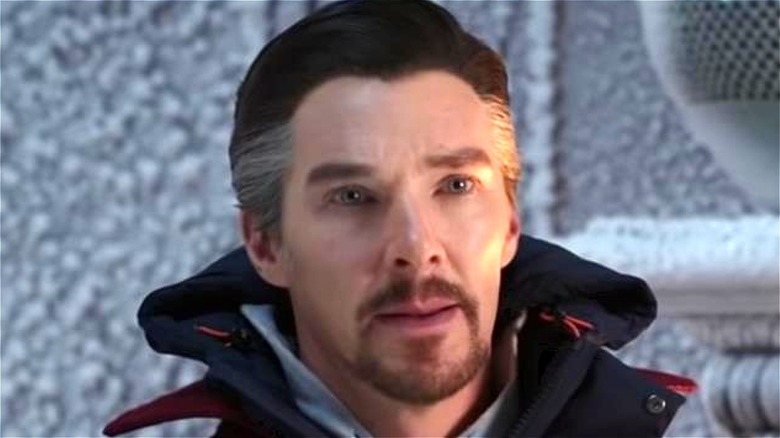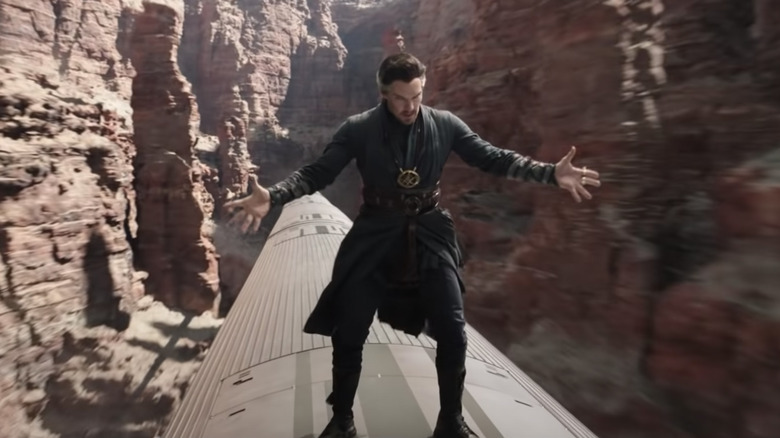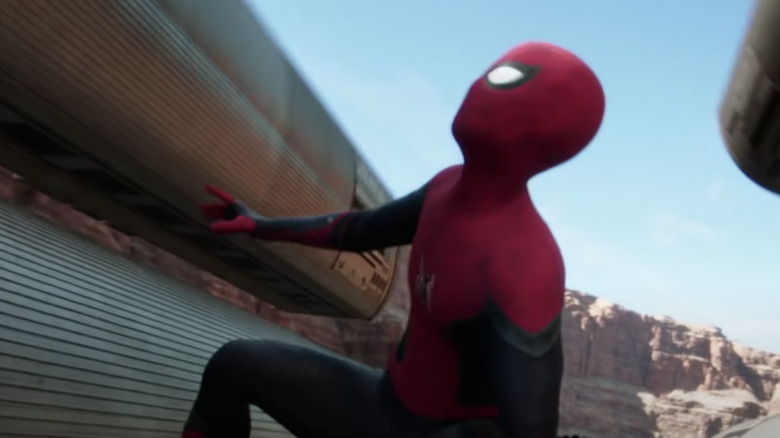It's Time To Talk About That Spider-Man Vs. Doctor Strange Scene From No Way Home
Contains spoilers for "Spider-Man: No Way Home"
"Spider-Man: No Way Home" is everything fans could have dreamed of and more. Not only did the film provide a satisfying conclusion to the MCU's first Spider-Man trilogy, but it also brought Peter Parker (Tom Holland) back to his grounded, working-class origins from the comics.
Of course, we'd be remiss if we didn't mention the most exciting part of "No Way Home:" the multiverse. Audiences were thrilled going in when they knew fan-favorite villains would all be returning, but the real thrill was seeing Andrew Garfield and Tom Holland suit up as Spidey once again.
Audiences first got a look at the inner-workings of the multiverse with the Disney+ series "Loki," and we'll be getting even more of this new stage of Marvel stories in next year's "Doctor Strange in the Multiverse of Madness." However, in "No Way Home," Strange (Benedict Cumberbatch) shows us another alternate reality we've seen before: the mirror dimension. It's the site of the eye-popping fight between the sorcerer and Spider-Man, and it's not the first time we've seen two Avengers go head-to-head. There was even a whole movie about that, "Captain America: Civil War," which was our first introduction to Spidey in the MCU.
Just like in "Civil War," Spider-Man and Dr. Strange are fighting because they both have different ideas of what is the right thing to do. Let's dive a bit deeper, though, and ask: Was Peter right for trapping Strange in the mirror dimension?
Strange and Spidey go head-to-head in the mirror dimension
Dr. Strange has always been adamant about not using his magical abilities to impact the fate of the universe. It's why he wouldn't destroy the Time Stone in "Avengers: Infinity War," and why he eventually gave it to Thanos to save Tony Stark's (Robert Downey Jr.) life.
Strange's pragmatic approach to being a superhero is magnified even more in "Spider-Man: No Way Home." Though he knows sending the villains back to their own universes will result in their deaths, he insists on doing it, saying it's their fate. Peter, however, wants to instead cure these enemies of their villainous afflictions before sending them home, thus giving them a chance to live. He's inspired to do this after Aunt May reminds him that it's their duty to help others whenever they can.
Strange and Spider-Man eventually get into a battle of spells and webs, fighting over possession of the magic villain-trapping box, officially called the Machina de Kadavus. The wizard brings Spider-Man into the mirror dimension, thinking the magically-induced realm would trip up the science-minded teen. However, it's Peter's flair for STEM that allows him to emerge from the fight victorious; he uses geometry to trap Strange in his webs and leave him suspended in the mirror dimension.
The scene is one of the most impressive in "No Way Home," and is certainly a testament to the power of VFX in storytelling.
Spider-Man is the hero he is because he always tries to do what is right
Like all of us as teenagers, Peter is idealistic, impulsive, and doesn't fully understand the workings of the world. He thinks that saving these villains is most important, but as he discovers, it comes at great cost, namely Aunt May's death and everyone forgetting he exists. His commitment to helping others is admirable, and a core part of what makes Spider-Man the hero he is. But if Peter had done the rational thing first, like calling MIT to ask for another shot at admission and accepting that he can't live two separate lives, Dr. Strange would have never cast the spell in the first place.
So, was Peter right to trap Strange in the mirror dimension and try to cure the villains against the wizard's wishes? We can't say for sure. Marvel movies are so great because they explore how our emotions can get the better of us and stop us from making practical choices. Nothing is black and white in the real world, and it's the same in the MCU. However, Peter ultimately understands and accepts the consequences of his actions, and the Peter at the end of the film feels much more grown-up than the one we first met in "Civil War." Helping others may not always be the practical or wise decision, but it's always the right one. Spider-Man shows us this constantly, and it's why we love him so much.


